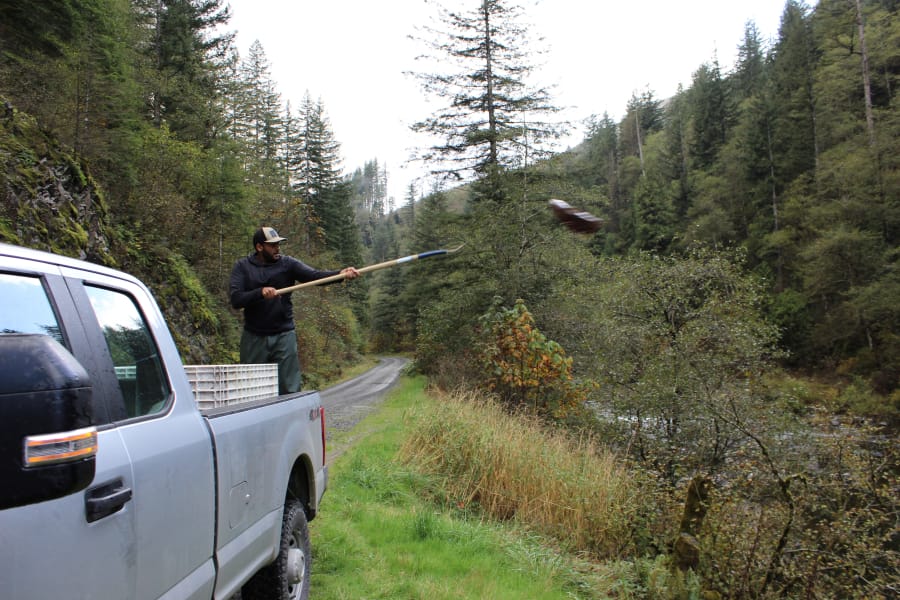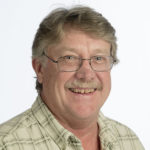The truck bounced along the rough gravel road as we pushed further up into the Washougal River watershed. The crystal-clear river plunged through the canyon, spilling over rocky falls and funneling into deep, green pools.
We pulled over at a bridge across a deep chasm where a small tributary enters the Washougal. Maurice Frank, the Restoration Coordinator for the Lower Columbia Fish Enhancement Group, (LCFEG), climbed into the back of the truck and began to pitch salmon carcasses over the side of the bridge and into the little creek below.
As the dead salmon plunged into the cold waters, Frank explained the importance of the carcasses to the river and the life it supports.
“Salmon spend a couple years in the ocean, come back, spawn and die — replenishing the nutrients,” said Frank. “Those nutrients feed bug life, plants, and other fish.”
“Not having those (dead) fish in the river system, the rivers get depleted.”
It is a part of the natural salmon life cycle that was not completely understood for years. Millions of returning salmon spawned and died in the rivers, dispersing marine-derived nutrients throughout the Northwest.
Those fish acted as a nutrient pump, replenishing the entire ecosystem. Animals ate the dead fish and spread the nutrients far and wide through their scat. Carcasses rotted in the creeks, feeding plants along the shore as well as aquatic insects, which in turn fed the next generation of young salmon growing in the stream.
With the arrival of industrial salmon fishing that began to change. As the fish were heavily harvested for the canneries less of them made it up to the spawning beds to replenish the streams. Many streams were completely blocked off, and entire runs were decimated.
Salmon managers responded by using hatcheries to supplement the runs, and those hatchery fish were removed from the system for brood stock and food. Again, nothing was left to replenish the streams.
The nutrient pump stopped. Streams lost their fertility, and the young salmon struggled.
Eventually, the connection was made, and managers realize now how important those carcasses are. Nutrient enhancement programs were started. However, spreading dead salmon around in streams is labor-intensive.
It’s dirty work, but these groups do it
Enter conservation groups such as the LCFEG, which organizes volunteers to do the heavy lifting of nutrient enhancement.
As restoration coordinator, it falls to Frank to organize the volunteers and pull off the work of spreading salmon carcasses in streams. It is a chore he enjoys.
“In my opinion it is the most important program because this doesn’t happen much as it did historically,” said Frank. “It’s almost too late, but we still have an opportunity to right our wrong, and that’s what I’m out here doing.”
Frank reports that the LCFEG has other projects to improve fish habitat, too, including invasive plant removal, replanting compromised areas with native plants from their two native plant nurseries, Fish passage barrier replacement, and large wood projects. However, this is the one he is most passionate about.
“This is the most important, because it finishes the life cycle,” he said.
Money for the nutrient enhancement programs has been provided by a grant from the Clark County Clean Water Fund. The fish used are surplus hatchery fish.
After the hatcheries have pulled fish for brood stock, and donated the better, usable fish to food banks and other programs, they donate what’s left to the nutrient program. On this day we were distributing Tule chinook carcasses from the Washougal Salmon Hatchery.
One of the things that Frank likes about this project is the chance to educate the public.
“When I do nutrient enhancement it engages folks because they will stop and ask, why are we dumping these carcasses in the river? It gives me the opportunity to educate them.”
“And then the light bulb turns on and its: huh, that is right. We are not just throwing salmon carcasses in the river. It’s a great educational tool.”
“We have been trying to expand the project out, because a lot of rivers do not have anything like this.”
The LCFEG helps distribute carcasses into other streams in Southwest Washington as well, including the East Fork Lewis, the North Fork Toutle, and the Kalama.
Frank said that the Clark-Skamania Flyfishers has been very active in these projects, and deserves thanks for their strong efforts in the East Fork Lewis in particular. The Coastal Conservation Association (CCA) of southwest Washington, and the Lower Columbia Fly fishers have also provided valuable assistance.
PacifiCorp has started a nutrient enhancement effort in the upper North Fork Lewis River watershed. This is in conjunction with the effort to introduce anadromy above the reservoirs along the river.
“Those fish populations are very important. That effort to go above the reservoirs is vital,” added Frank.
The importance of these carcasses to the ecosystems they replenish is an easy issue for most people to connect to.
“With all the issues we are facing, including climate change, there is a lot of confusion out there,” said Frank. “This is one thing that we know makes sense; common sense.”
Volunteers welcome
Frank is always looking for more help, and he said that anyone that wants to come along is more than welcome.
“We are always looking for volunteers,” said Frank, “We try to get as many folks together as possible.”
Prospective volunteers can call Frank at 360-953-1480. They can also e-mail him at Maurice@lcfeg.org
For more information: Lower Columbia Fish Enhancement Group, https://www.lcfeg.org.




